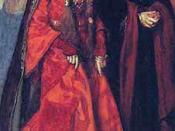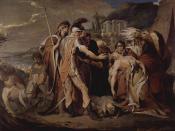Tracing Aristotle's tragic hero model in "King Lear" and "A Streetcar Named Desire":
Aristotle defines tragedy as a form of drama which imitates noble people through artistically enhanced language and through pitiable and fearful incidents. According to Aristotle, tragedy involves several aspects that eventually lead to catharsis, an emotional cleansing of the audience. Some of these aspects include pity, fear, reversal and recognition. Reversal of fortune (peripeteia) is "an incident in which the tragic hero undergoes a reversal of fortune to the opposite state of affairs" (Section 11). Recognition (anagnorisis) occurs when "the hero undergoes a change from ignorance to knowledge and brings about a state of friendship or one of hostility in the tragic figure" (Section 11). These stages occur simultaneously in a complex plot is order to create feelings of pity and fear with catharsis as the main goal. Both William Shakespeare and Tennessee Williams present tragic heroes within their respective plays, King Lear and A Streetcar Named Desire; however, while Shakespeare accomplishes this by following Aristotle's tragic model rather closely, Williams adapts Aristotle's model to better suit a 20th century audience.
Both tragic heroes, King Lear and Blanche DuBois, have tragic flaws as defined by Aristotle. According to Aristotle, every tragic hero is a "person who is neither perfect in virtue or justice (Section 13)." Shakespeare describes Lear's flaw as pride. This flaw is evident when Lear informs his daughters he will award the "largest bounty (King Lear 1.1.57)" to the daughter that professes his love for him in the best possible way. In other words, Lear is looking for ways to feed his pride. As Aristotle said, this tragic flaw leads to the downfall of the hero. In this case, Lear loses all his wealth to his daughters and wanders around homeless.


